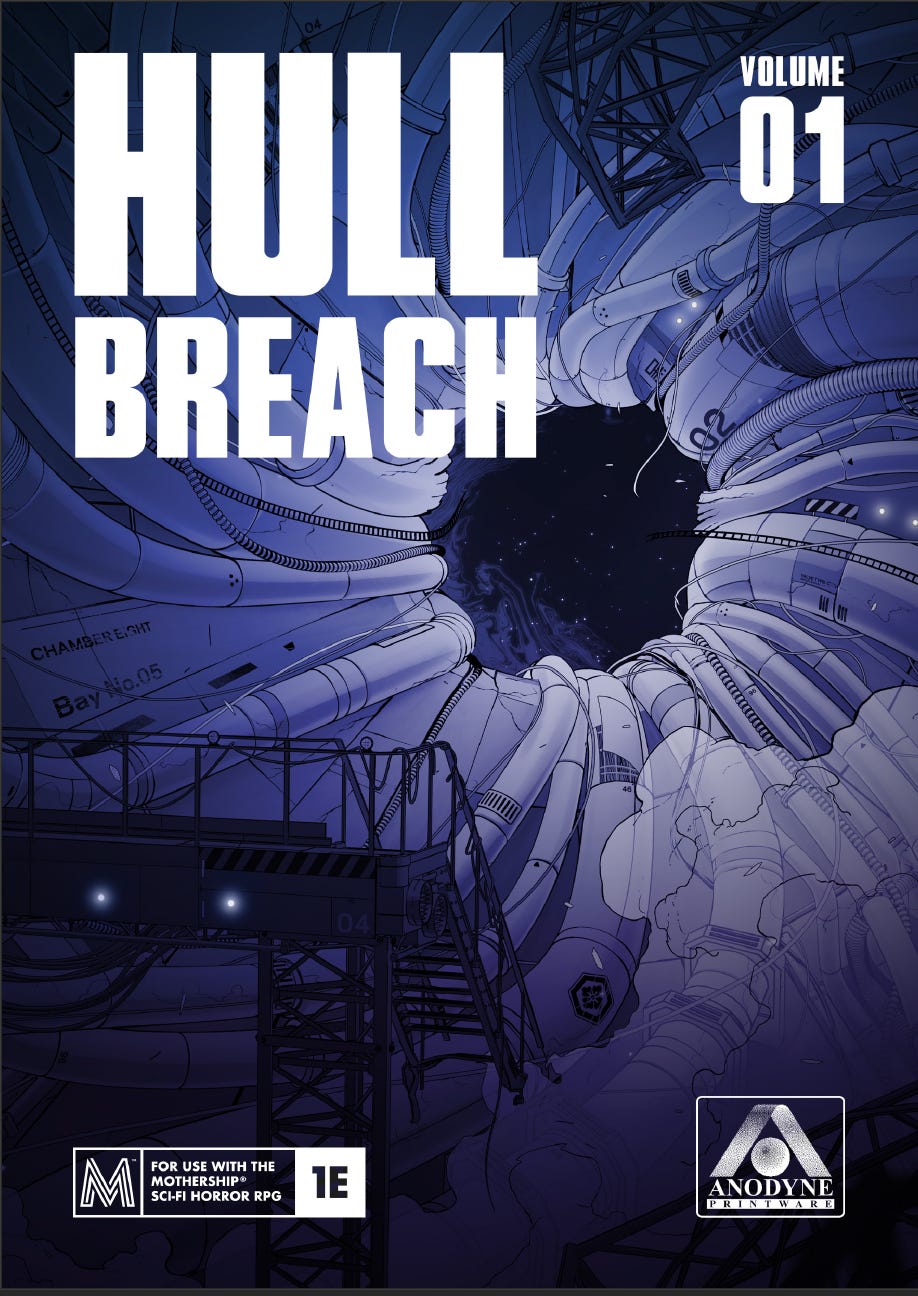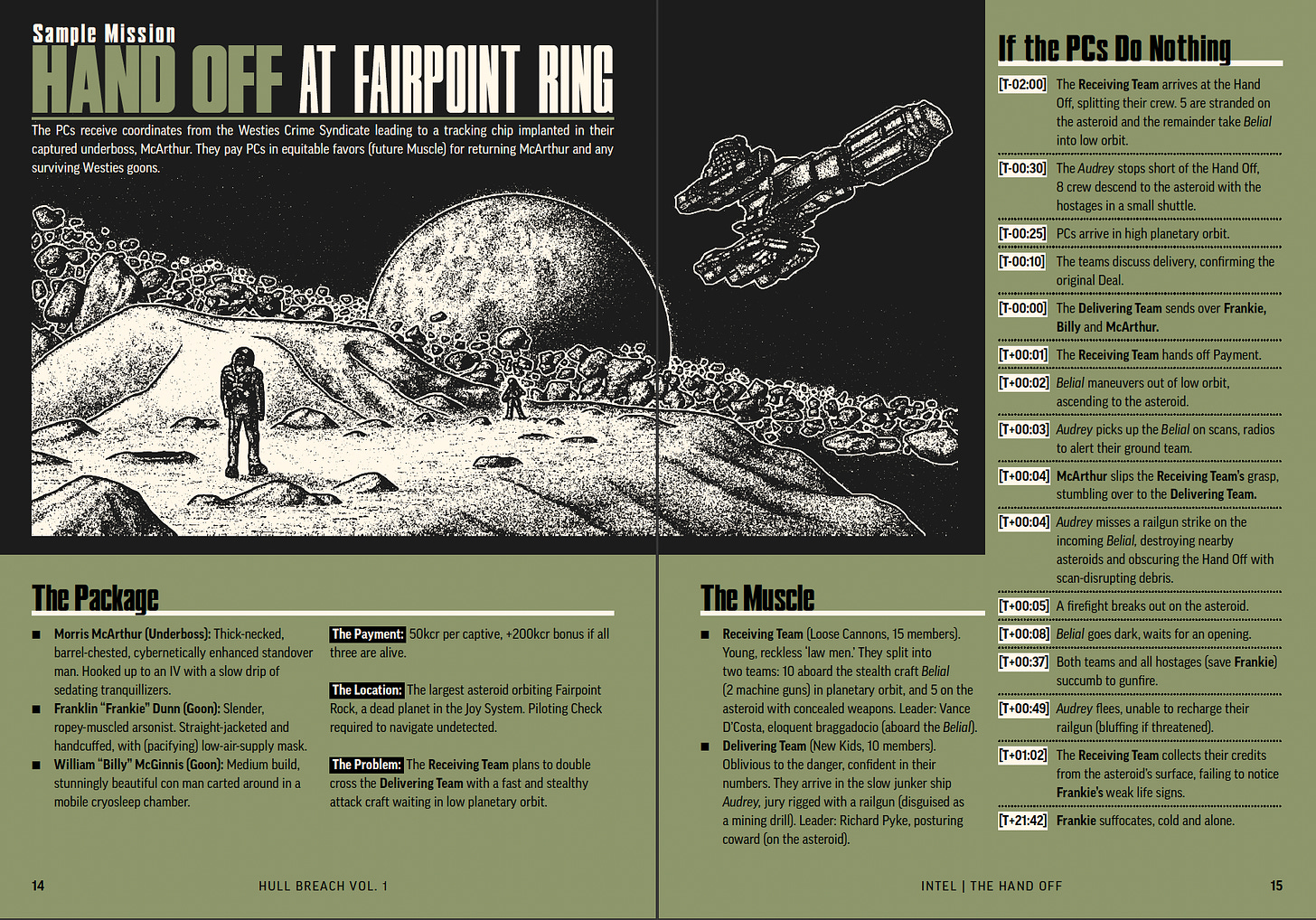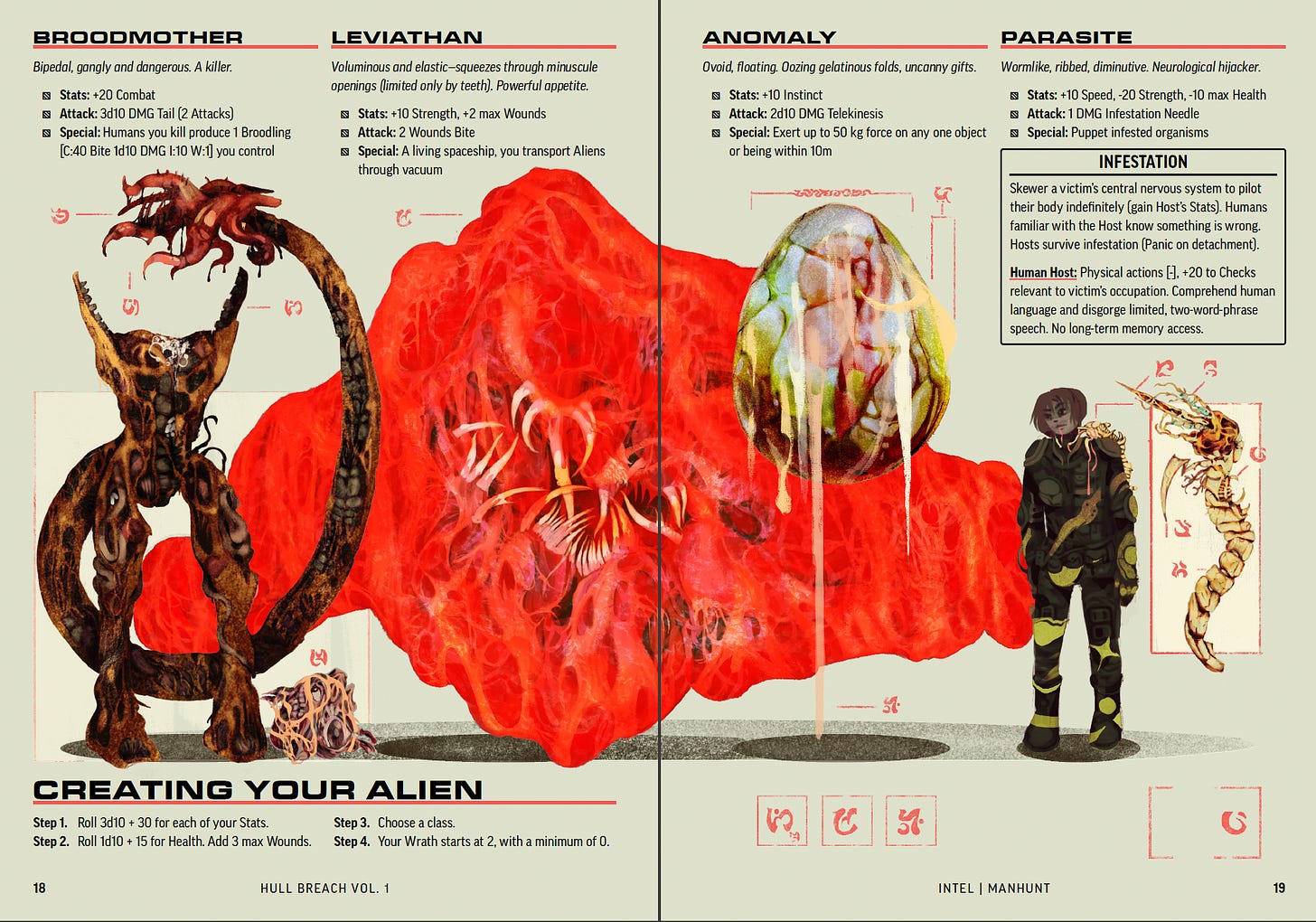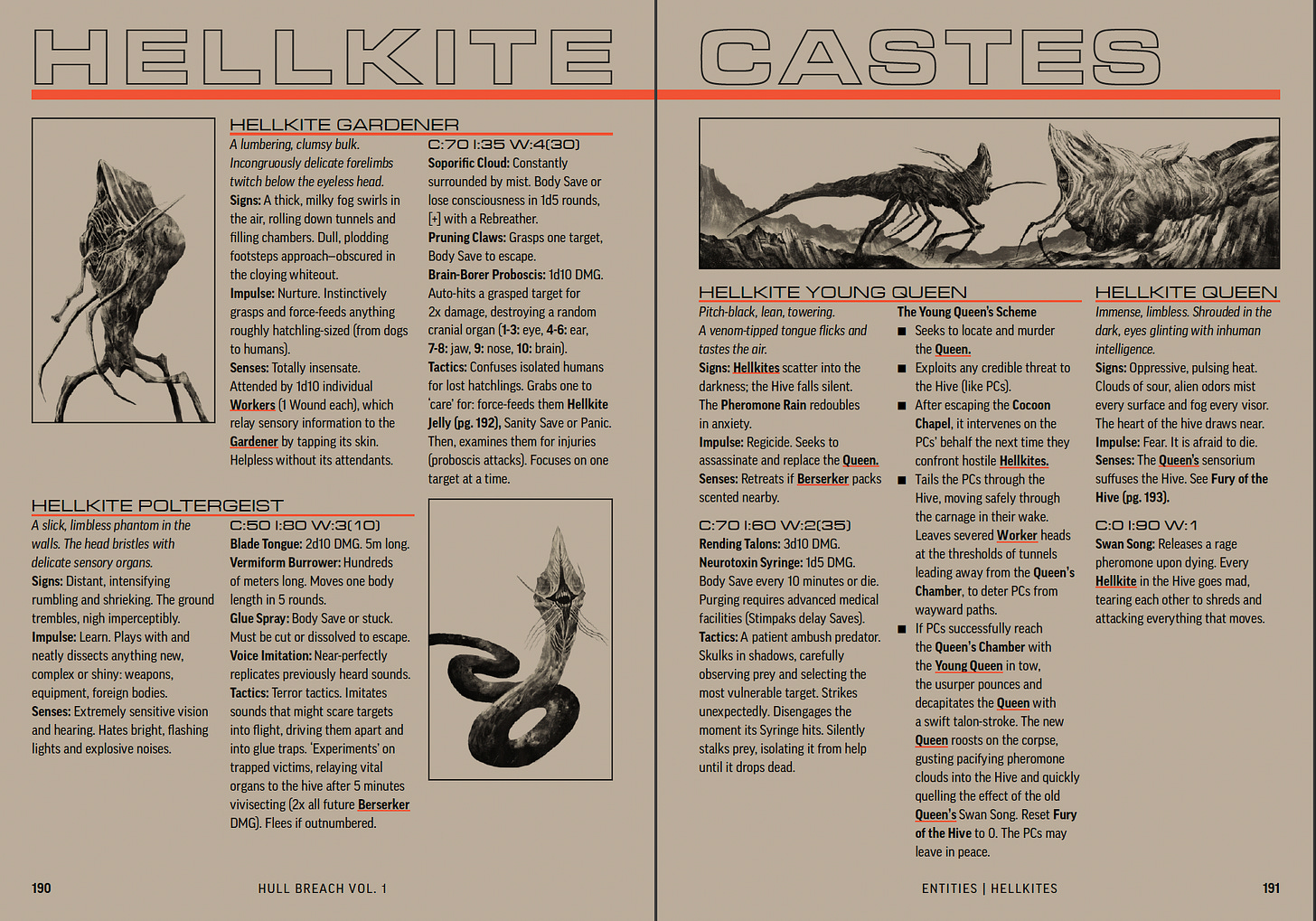Hull Breach: Volume 01 (available here) is a 3rd party companion for Mothership, the ttrpg of space horror in the tradition of Alien and Event Horizon. Hull Breach is an anthology developed and produced by Ian Yusem, consisting of 26 different entries by 24 different authors, with layout and design by Eric Hill, Lone Archivist, and Meredith Silver; editing by Fiona Geist and Jarret Crader; and art by Nikolai Fletcher, L.F. OSR, Sajan Rai, Daniel Vega, and Joshua Clark.
I’m reviewing Hull Breach here on Mazirian's Garden rather than on Bones of Contention for the simple reason that Ian Yusem, whom I know a little mainly by having been in a couple of discords over the years, asked me to take a quick look at the PDF of the penultimate draft. Given our draconian policy on conflicts of interest, this excludes me from being eligible to review it on Bones. But I find myself with a lot to say about it, so I wanted to say it here.
The anthologies is divided into 5 sections. The first is “Intel”, which deals with toolkits and procedures, including some tips for running horror and investigative games, and a couple of entirely new ways of running Mothership, like playing as the monsters or playing without a warden (GM). “Missions” presents jobs that players can take, which is the basic setup for adventuring in Mothership. “Locations” includes stations and planets, along with a couple of location-based adventures. “Entities” presents alien monstrosities, colorful NPCs, and corporate patrons. Finally, “Assets” presents new equipment and technology.
In organizing these diverse elements, Hull Breach sets a new standard for anthology companions. It lays down a template that could and should be replicated for almost any game or genre. The main innovation has to do with the way in which these 26 discrete contributions are woven together so that they can each be used not only a la carte but also as a single campaign.
This integration happens at 3 levels.
Most importantly, in a total of 12 action packed pages—including the 4 endpapers!—Ian creates a framework for all the contributions. We get a simple map of 3 different connected sectors where locations from the anthology are placed, and three different corresponding campaign frames: one of corporate intrigue set in core space, one about survival horror set in the fringe of rimspace, and one about exploring the unknown set in frontier space. Each frame has a different suggested starter adventure, a different package of recommended article to use, and a few suggested follow up adventures from the anthology.
We also get a set of simple procedures for space travel between destinations and a nice reputation mechanic, which has to do with how corporate friendly or subversive and criminal the PCs are being, affecting the kinds of jobs they get offered over time. There is also a system of “campaign causality” where certain consequences are triggered when set conditions are met pertaining to the different articles in the anthology.
There are a couple of extras including a corporate pyramid that shows how different corporations, mentioned in various articles, are related to one another, a set of rumors pitched as conspiracy theories, and some loot tables that reference different parts of the anthology. We also get a worksheet for a campaign that tracks all these elements.
None of the individual elements is rocket science taken alone. But together they show you how you can use the many articles in the anthology to run a solid campaign. Since the anthology is so modular, it’s easy to imagine expanding the resources for a warden to include other published adventures for Mothership, which could easily be dropped into the framework. It’s turns what threatens to be disjointed articles into a tidy package.
At a second level the individual articles have clearly been edited to include many references to other articles. Gear from the “Assets” section shows up throughout, as do people and aliens from the “Entities” section. More impressively, adventures often contain hooks to other adventures, creating a coherent, interconnected campaign from 26 distinct articles that can also be used separately.
At a third level, by having only 4 artists, and layout done by only 3 different individuals, the work has a consistent look and feel to it. Again, there’s a nice compromise between modularity and system. Each article has its own distinct color scheme and graphic design, and yet consistent typeface is employed, and none feels jarring or out of place. The artwork is especially good, often exquisite. From L.F. OSR’s lonely black and white stippled architecture, to Sajan Rai’s gorgeous, painterly monstrosities; from Daniel Vegas’ deliciously hellish concept art, to Nikolai Fletcher’s classic sci-fi gear and schematics illustrations—the artwork just doesn’t miss a beat.
In terms of the content, not all the articles will be equally useful for all wardens, and not all equally tickled my fancy. But there were many that were manifestly useful for any campaign, and a few that were flat out great.
The award for my favorite single article goes to Bones and Videotape by Matt Umland with art by Joshua Clark, a truly ingenious sci-fi puzzle dungeon. It belongs to that genre where the players go into the dungeon not knowing what is going on at all, and they have to puzzle out the rules of the space they’re operating on the fly. It also has what will almost certainly be an amazing dramatic reveal. Plus, you’ve got to love a horror adventure where characters are encouraged to stop in the dungeon to playback videotapes they recover on a clunky videotape player. I wanted to run it immediately upon reading it, which almost never happens to me.
Other quite good adventures include Road Work by Brian Stauffer with art by Daniel Vega, which has the PCs trying to escape a loop while traveling through alternate versions of reality (the solution Stauffer envisions is a touch over-specific, but the details of the adventure are quite good). and Vibechete by Joel Hines, which brings classic slasher horror to Mothership for a rollicking good time.
Another delightful article and adventure pair was Ian Yusem’s clever flipping of the Motherhip script in Manhunt, which has the PCs playing as alien monsters who are hunting the true monsters: human beings. There are four different imaginative varieties of monsters you can play, all illustrated beautifully by Sajan Rai, along with a neat mechanic where the monsters evolve as they become enraged by human cruelty or violence. His brutal one shot, Churn Rate, which involves monsters trying to escape a corporate alien zoo, seems like it would be a lot of fun.
The award for the most useful single article goes to Corpocrat Dogs by Quadra with art by Sajan Rai, which presents randomly generated corporate handlers, each with a name and appearance, a grating modus operandi that almost guarantees that the players will love to hate them, a dark secret that will lead to trouble down the line, and a mission generator referencing the contents of other articles. Since in Mothership, the characters are almost certain to be bumping up against needy corporate types, I think this article could be used in any campaign, probably multiple times. Another useful article is the writeup on Xeiram, a terrifying corporate enforcer intended to plague the PCs when they cross their corporate overlords, written by Daniel Hallinan with art by Sajan Rai. I also found the writeup on Hellkites, hive-dwelling alien insectoid horrors by Mystery Spice with art by Daniel Vega solidly useful.
The lessons of Hull Breach: Volume 01 are immediate and obvious. It presents a template for ttrpg anthologies that deserves to be reproduced. It will probably work best for anthologies produced for games with a coherent setting or at least a shared vibe and genre. For example, it is easy for me to imagine an anthology that follows this format for other sci-fi or cyberpunk games like Gamma World, Traveler, Star Frontiers, or Cyberpunk 2020. But it’s also easy for me to imagine something with this template for a sword & sorcery setting like Hyperborea. Here one might present a similar division of novel procedures and toolkits, quests, locations, factions and monsters, as well as spells and magic items. These could then be woven together in a simple hexmap, with a reputation score that affects reactions rolls with different factions, campaign causality triggers keyed to different articles, the whole Hull Breach works. With a little work the articles could be woven together, adventures seeding other adventures, referencing spells, locations, and monsters in other articles, along with unified artwork and aesthetic. Yusem and his crew have shown you the way. What are you waiting for?





No comments:
Post a Comment